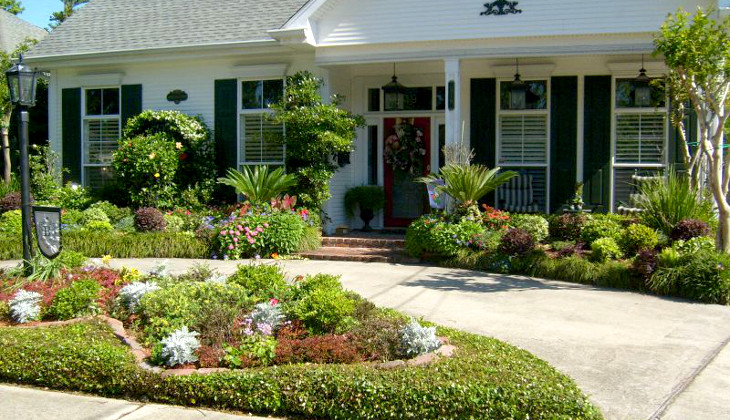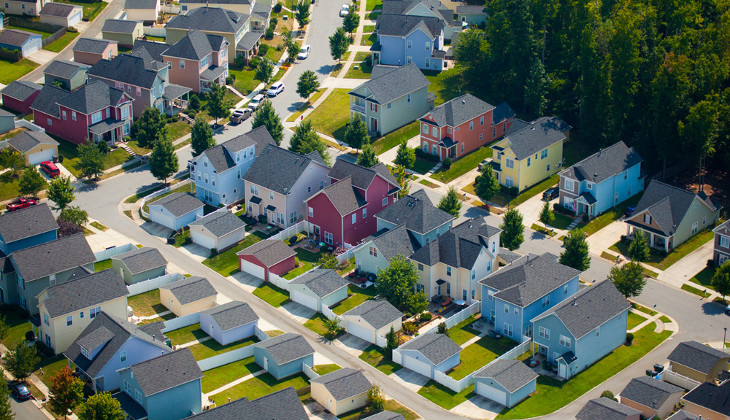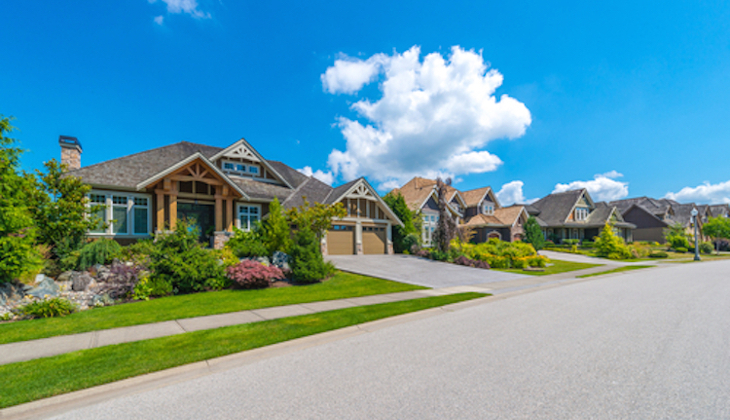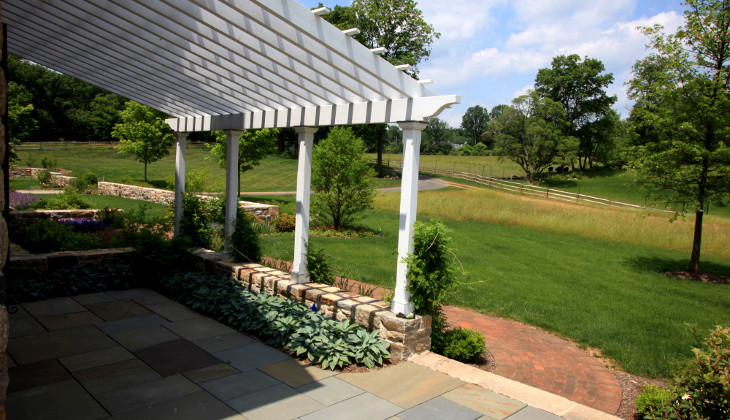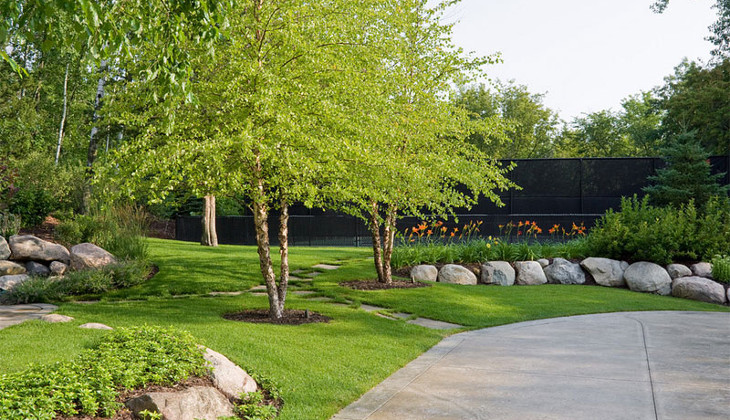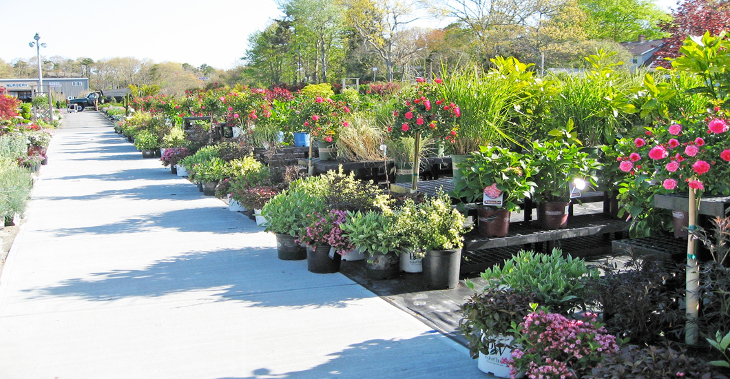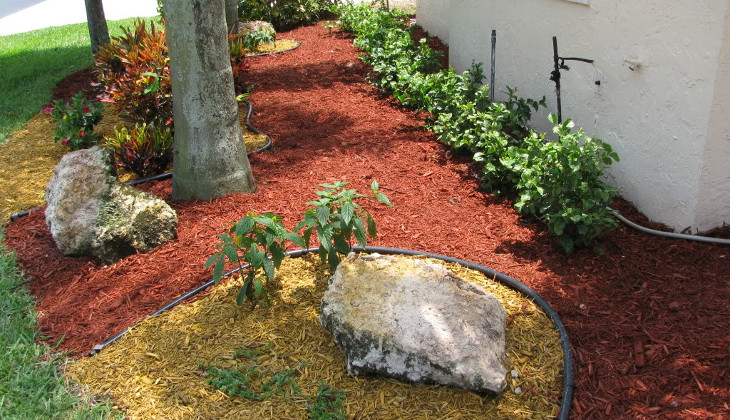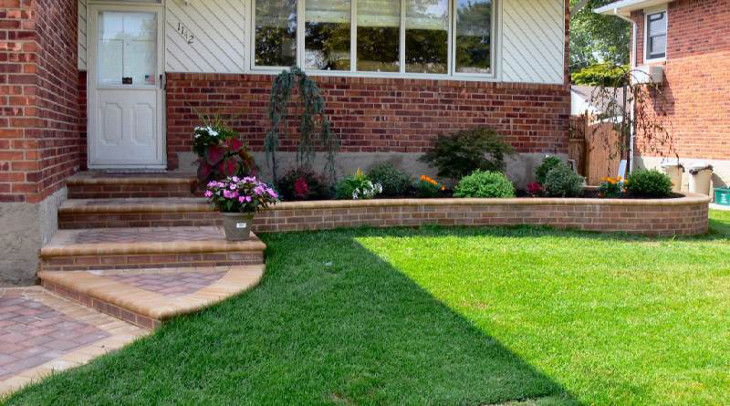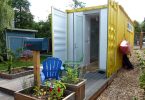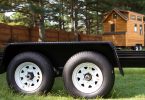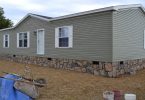Mobile home landscaping is the perfect way to transform your yard into paradise. Your imagination is the only limit to what you can dream up for your home. Create a Zen experience with a Japanese garden, or use some palm trees and exotic plants for a Mediterranean look and feel.
If you’re a home chef, the Cottage Garden may be for you, complete with seasonal fruits, vegetables, and herbs. No matter the style, you can adapt it to fit the space you have available. Now that you’re inspired, it’s time to dig in and begin designing.
Design your landscape
Grab some pencil and paper, and think about what you envision for your mobile home’s landscape. Think about the space you have available and the features you want. A feature can be thought of as something you will have to build, such as a deck, patio or pergola.
Next, think about pathways and where they will run and then block in the spaces where you will plant trees, shrubs and other vegetation. If you plan to have lighting, think about its primary purpose.
Decorative lighting can be used as an accent or to light certain plants at night, where functional lighting will be used to light a space, such as a seating area. Once you have your landscape design complete, it’s time to start planning.
Landscape Planning
The planning stage involves getting homeowner authorization and building permits when applicable and lining up all the materials you will need to create your landscape. Always make sure you have all the proper authorizations and permits in hand before building anything on your property. Failure to do so may result in legal action and fines.
Homeowner Associations and Groups
If you belong to a homeowners association, the first thing you will need to do is make an appointment to meet with them. Be sure to bring a copy of your landscape design to show them as well as a written outline of what you intend to build.
Some associations have restrictions on what you can do with your property. If there are restrictions, make note of them. Revise your design to comply with those restrictions and re-submit for approval. Upon approval, you will be able to obtain any building permits you may need.
Building Permits
If you plan to build a deck, pergola or any other structure, find out what the local laws are to see if you need a building permit. When requesting a building permit, make sure you include all structures you plan to build. In some cases, you may need multiple building permits since you may need more than one.
If you plan to run plumbing and electrical outdoors, make sure your permit covers it. Failing to make sure your building permit covers everything you intend to do may result in downtime and fines.
Local Ordinances
Make sure your landscape won’t be in violation of any local ordinances. Some cities have strict ordinances in place. These restrictions can include outdoor structures such as decks and fountains, or even certain plants. Since local ordinances vary from one municipality to the next, make no assumptions about what’s permissible and what isn’t.
After you have obtained all permits and authorizations, it’s time to start building your landscape.
Building Your Landscape
Before you begin building, it is a good idea to sit down and figure out what to build first. What to build should be prioritized based on when it will be easiest to install. Depending upon the structures you plan to include in your landscape, you may need to decide if and when to pour your concrete.
A good rule of thumb is to determine if the structures you build will be secured with posts set in the ground. In that case, build those structures first, then pour the concrete. To help you figure all of this out, use the list below as a general outline of what to do and when to do it.
Electrical and Plumbing
Run your plumbing and electrical first. This saves having to go back later and dig things up.
- Plumbing If you live in a climate that gets cold, carefully consider how you plan to winterize your fountain or other outdoor water feature. When a frozen pipe breaks, it can cause a lot of damage quickly. Or, in the case of an outdoor pipe, it can crack and leak, running up your water bill. To winterize, install the water valve for your fountain inside with a way to drain the pipe. Draining and covering your outdoor water feature will prevent water from getting in the water supply pipe and freezing it.
- Electrical Whenever you run wiring outdoors, make sure to run it through conduit designed for burial underground. This will keep your wiring clean and dry, and allow you to keep it out of sight. Both metal and plastic conduit is available; check your local building codes to find out which you can use for buried outdoor wiring.
- Outdoor Lighting Properly placed outdoor lighting makes it easy to enjoy your paradise late into the night. It also creates a dramatic display of your landscape while improving the security of your home. There are a wide variety of options available, from solar-powered path lights to LED light fixtures that can display colorful patterns on your landscape and home at night. For all outdoor lighting, use fixtures that are designed to withstand all types of weather.
Structures
Anything you have to construct is a structure, such as a deck or pergola. If you plan to build something, make sure you have the authorization and permits before you begin building.
- If you plan to build a deck, take some time to learn about how decks are built. When you build your deck, be sure to use wood that has been treated for outdoor use, or stain it with a quality outdoor stain. This will help you build a deck that will be safe and beautiful for years to come.
- Another seating area that is built right at ground level. Patios usually are made with some kind of durable, weather-resistant surface, such as concrete, brick, or pavers. When building a patio, it is important to prepare a stable, level base for the patio surface. Otherwise, the patio may crack and become uneven over time as the soil beneath settles. Drainage is also important; a lack of drainage can lead to water pooling on your patio and freezing, causing damage to your patio’s surface.
- This is an outdoor structure characterized by an open roof and walls. Pergolas are generally made out of wood and are used for seating areas. For a quick and easy construction, kits are available that provide all the wood and hardware needed to build a pergola in less than a day. If you prefer a material other than wood, you can build a pergola out of metal, stone, PVC pipe or brick.
- Playground Structures Swings, slides, playhouses and other structures designed for children to play on can often be purchased as kits that are easy to assemble and install. Make sure each play structure is installed on level ground and secured in a way that prevents them from tipping over.
- Fountains. Fountains come in every shape and size and are made out of a wide variety of materials including concrete, stone, fiberglass and plastic. When choosing a fountain for your landscape, carefully consider the climate. Plastic is the least durable material, while stone is the most durable.
- Fireplaces and Grills. Your outdoor grill or fireplace can be made out of brick, stone or concrete. These structures require special consideration due to the intensity of heat radiated. If placed too close to a house, an outdoor grill can melt or burn your siding. Outdoor fireplaces are usually a feature in a seating area that is at least several feet from the house due to its size and the amount of heat it will radiate when in use. If you plan on building an outdoor fireplace, be sure to install a spark arrestor in the top of the flue. This will prevent sparks from flying out and starting fires. A spark arrestor will also help keep birds from nesting in your fireplace.
- Concrete A popular outdoor surface for sidewalks and seating areas, concrete is easy to mix and pour. Care must be taken when preparing to pour concrete. The ground must be leveled with a layer of gravel on top to provide drainage and a stable surface for the concrete to lay on. If you plan to pour concrete on a large area, you may need to plumb it or slope it for drainage. You may also want to score a large concrete area so that it cracks along the scores when it freezes. This helps to prevent random cracks that can lead to crumbling concrete over time.
Trees, Shrubs, and Plants
One trip through the local nursery will have your head swimming with ideas for what you want to plant. Before you buy a single plant, do some research. For a thriving paradise, you will need greenery that can survive in your climate. You will also have to think about your soil.
Different plants require different Ph levels and nutrients. Also, don’t forget the sun. While some plants thrive in full sunlight, others will wither up and die. Use the section below to help you determine what you will plant and where.
Trees
A beautiful addition to nearly any landscape project. There are two basic categories of trees: deciduous and evergreen. Deciduous trees have leaves that fall off, usually in the autumn, while evergreen trees stay green all year round. Some things to consider when looking at trees include how big they will grow.
If you plan to plant trees close to your house, opt for trees that have smaller crowns (leaves and branches). Their roots will be smaller and less likely to damage your home’s foundation. When looking at trees, think about its role in your landscape. Will it provide shade for plants or people?
How will its placement affect sunlight coming into your home? In some cases, you may want to block some of that sunlight. Purely decorative trees should be chosen and placed based on where they will be the most attractive without obstructing the view out your windows.
Shrubs
These make an attractive backdrop for your flowers and showy plants. Like trees, you must be careful when choosing them, paying attention to how big they will grow. Properly placed shrubs can provide much-needed shade for sun-sensitive plants, protecting them from the withering rays of the sun.
Shrubs are available in deciduous and evergreen varieties, with a lot of choices for leaf color, density and flowering species. Some species, like Juniper, get bright berries on them. Shrubs that bear fruit will attract birds for an added dimension of enjoyment.
Plants
Relatively inexpensive and easy to care for, plants often make up the bulk of greenery in a landscape. As you look for plants, be sure to purchase plants that will grow in your climate. Also, choose a mix of perennials (plants that come back year after year) and annuals (plants that have to be re-planted every year).
Plants are sensitive to soil, so be sure to test your soil’s pH before you buy any plants. This is a measure of how alkaline or acidic your soil is. Thankfully, you won’t need a degree in soil science to use pH. Soil test kits are readily available at garden centers and nurseries.
The instructions included with each test describe how to use the soil test kit and how to interpret the results. This will help you to provide the nutrients your soil actually needs. Applying too much of the wrong thing can harm or even kill your plants.
Mulch
One of the greatest ways to beautify your landscape and save a lot of work is to mulch around your trees, shrubs and plants. This helps to hold moisture in the ground while keeping weeds out. Mulch is available in a variety of materials including chipped bark, ground rubber, shredded plant fiber, woven fabric and gravel.
For play areas, ground rubber mulch is durable and less likely to result if scraped knees and hands if a child falls on it. Woven fabric is usually made from polyester and can be cut to fit around all of your greenery. Weeds and grass will eventually punch through, however, so you may want to cover it with chipped bark, gravel or other mulching material.
Stone Mulch
Stone mulch is available in a wide variety of sizes from large rocks down to pea gravel. Stone mulch is highly durable and available in a multitude of colors. This kind of mulch works best if you lay mulching fabric or plastic sheeting underneath.
Otherwise, the gravel tends to sink down in the dirt. Gravel also tends to become discolored over time, due to staining from plants, soil, and algae/moss growth.
Maintenance
Dreaming big is easy, but we often forget to factor in how much effort it will take to take care of our lush landscape. When designing your landscape, keep in mind what it will take to maintain each part of it. Wood structures and features will need to be re-stained or painted every few years, along with periodic repairs as boards come loose and break.
High-maintenance plants and shrubs may look lovely when they’re new, but tending to them every few days may quickly become tiresome. Factor these considerations in early to keep your maintenance needs simple so that you can easily maintain your landscape for years to come.
Get gardening
Landscaping your mobile home takes a lot of work, but it’s worth it. Taking the time to carefully design your miniature paradise results in thoughtful design that will be easy to maintain after it’s built. Planning is also necessary, especially when it comes to obtaining the building permits and authorization needed before you begin building.
With your revised design, permits and signed authorization in hand, you can begin building. Using your step-by-step process, you build your structures first, such as a deck or patio area, then pour concrete or may pathways. After all your landscape features are in place, you can begin planting your greenery.
Finally, after all the work is done, you can step back and admire your new paradise. Better yet, grab something to drink, sit back and enjoy your new paradise.
What did we miss? Do you have any experiences landscaping your mobile home that you would like to share? Send us your thoughts!

